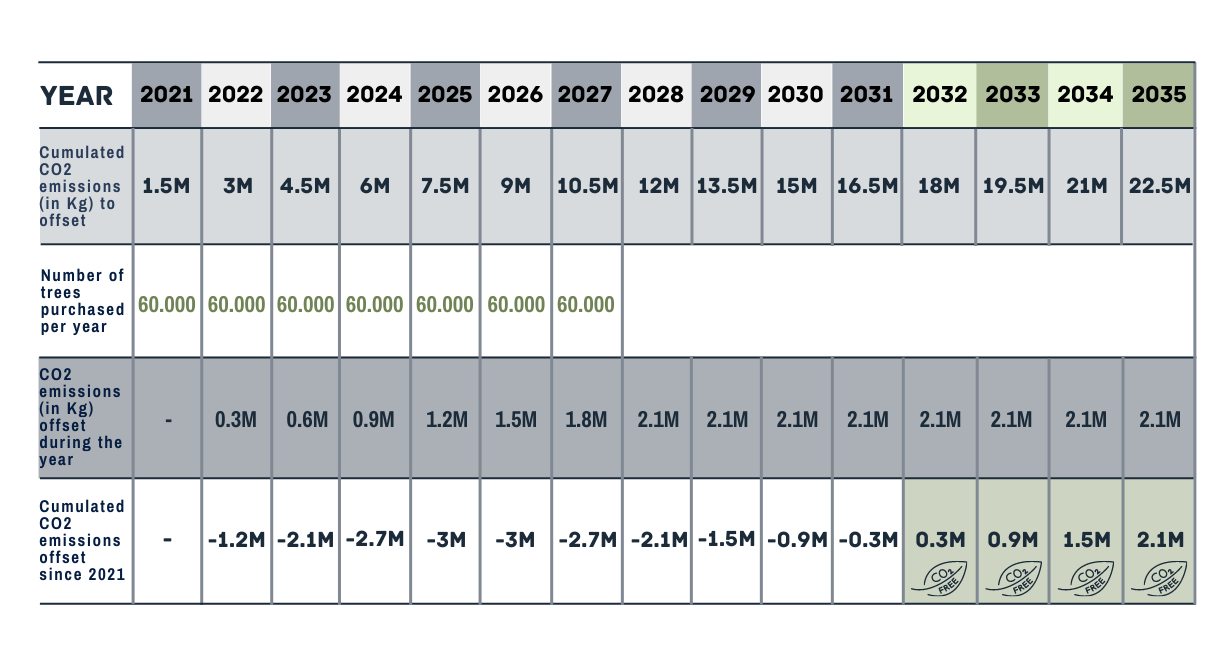Our plan
- Cumulated CO₂ emissions (in Kg) to offset: Data collected through the french method “Bilan Carbone”©. We estimate that we emit around 1.5 million kg of CO₂ per year. These figures are expected to reduce year on year through our emissions reduction strategy, average figures were used to calculate this offset estimation.
- Trees purchased per year: We plan to purchase 60,000 trees per year over 7 years. That is a total of 420,000 trees planted over time.
- CO₂ emissions (in Kg) offset during the year: 5kg of CO₂ is offset per tree, per year (over a 20-year period). Since 2021 the land is being prepared for the plantation of the trees in 2022.
- Cumulated CO₂ emissions offset since 2021: We subtract the number of kilograms of CO₂ emitted from 2021 cumulatively with the number of kilograms of CO₂ offset during the current year.
The calculations are based on estimates both for carbon emissions and for tree compensation and can not be considered as precise values. An annual follow-up is carried out with the associations and our supplier for carbon footprint calculation.
This means that, for an annual carbon emissions of 1.5 million kilograms, and starting our project to offset our carbon emissions in 2021, we should be carbon neutral around 2032. It is possible that we will reach our goal before 2032 if our strategy to reduce carbon emissions is effective, however, it is also possible that it will take longer than expected: in the event of bad weather or damage or dead trees.
Offsetting carbon through tree plantation is not an exact science, however, it is an interesting complete solution as it not only helps the company to reduce its impacts, but also brings a great number of environmental, social and economic benefits.
Graine de Vie project
We have chosen to plant our 420,000 trees in Madagascar, in the region of Diana located in the north of the island.
In this region, we are replanting the mangroves. The mangrove trees are not only excellent carbon storage support, they also offer protection against the frequent cyclones in the region, and constitute a shelter for marine fauna, favouring the proliferation of fish. It is not only the biodiversity that is increased, but it is also an additional source of food for the inhabitants and a source of income through the trade of these fish. Of course, trees are planted in agreement with local institutions and locals are hired and paid to plant and maintain the mangroves.
The local population is being informed and sensitised concerning environmental issues and to why restoring these plantations is essential and vital. By doing this we are giving the project every chance to reach its goal.
Canopée project
We work with Canopée on smaller projects that help farmers in our region thanks to agroforestry.
For example, in the region of Dinant in Belgium, we financed a project to plant a windbreak hedge to host biodiversity, as well as a hazelnut orchard. Both projects will respectively offset a total of 19.6 tonnes of CO₂ over the next 20 years. The mixture of soil used to plant the trees also offsets around 1.6 tonnes of CO₂.
The goals here are diverse: reception of biodiversity, windbreaks, drainage of rainwater, fruits, timber, increase in organic matter and therefore soil fertility, protection from the sun, animal well-being and finally the storage of CO₂ in carbon. To ensure the long life of these plantations, the farmers undertake the maintaining of the plants for a minimum of 20 years and insuring not to use harmful products.


